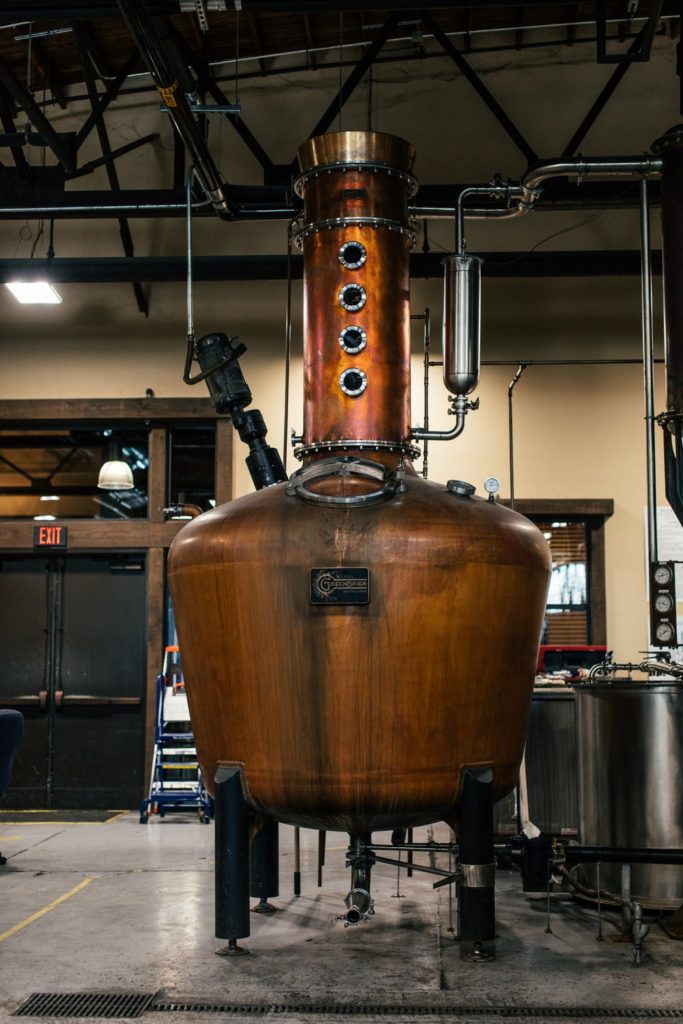The distillation of whisky is nothing less than a sublime art form. For this reason, the “artist” in this case seems all the more surprising. Are you wondering why?
Well, because the modern distillery seems like it would fit right into Charlie’s Chocolate Factory!
Distilleries hold either massive columns connected by a tube network or huge squat pots, depending on the distilled product. In fact, it is these complex mechanisms that are responsible for distilling your favorite spirits!
The intricacy of distillation equipment leads many to think that the process is quite confusing. However, it is pretty straightforward and equally fascinating.
This article intends to be your guide to the art of distilling whisky. So read on if you have a healthy appreciation for the old spirit!
The Principle Of Distillation Whiskey
The principle of distillation has been around since the time of the ancient Egyptians.
However, they only employed distillation to manufacture perfume. It wasn’t until the Middle Ages that Celtic Monks first produced whiskey, which gained fame as “the water of life.”
The Process
Distillation involves the separation of substances through heat due to varying evaporation points. Distillers can then collect the substances that are first to evaporate.
These liquids with lower thresholds are held separately. Due to alcoholic fermentation, the wash will have around 8-10% alcohol (ethanol, ethyl alcohol). The strength of this alcohol depends on two factors.

For one, the yeast used influences it. Also, the duration of the fermentation period has a role to play. As the wash heats, substances with lower boiling points than water will evaporate quicker.
The highest temperature to which you can heat the wash is the evaporation point of the lowest-boiling substance. The substances absorb all the heat energy transforming from their aggregate states.
Once these substances become vapors, the remaining liquid can no longer be heated. Only after all the substances evaporate at this exact boiling point can the leftover liquid be heated again.
Ethanol will evaporate at 173.3° F or 78.5° C and at the standard air pressure of 14.69 psi or 1013 hPa.
The Equipment
The standard equipment for a Scottish malt whisky distillery includes two pot stills. Some distilleries may even take it a step further with three pot stills and triple distillation.
Read more about pot still.
Even larger distilleries feature four, six, or more pot stills. Distilleries usually operate these stills in parallel instead of in series. Pot stills typically have a very intricate connection.
For instance, the first distillate from multiple production cycles or many wash stills is collected in a single spirit still. Distilleries
also often use wash still to spirit still ratios of 3:2 or 4:3.
Distillers can even use two pot stills to triple-distill a spirit with a simple process. All they need to do is distill the end product from the second distillation once more. After that, they may collect it in the emptied spirit still.
Which Still Type Is Best For Whiskey?
When people think about alcohol production, they often think of pot distilling, and for good reasons. This distilling method has long been known to create rich and complex spirit flavors.
Read more about distillation process you can in the article How to make moonshine at home. In this section, we’ll be covering the process of the whiskey distillation in greater depth.
Wash Still
The purpose of the wash still is pretty straightforward. This still’s role is to perform the first distillation of the wash or the beer. Wash stills typically have a synchronized capacity, with 4,000-8,000 US gallons being the most favored.
As hot steam fills the heating cylinders, the wash still begins heating the beer. The movement of the heat within the still, or the convection to be more technical, turns the wash.
So within the cylinder, the beer tends to rise in the warmer areas and sink in the cooler parts.
After about 30 minutes, the liquid above the heating cylinders begins to boil. Soon light substances, flavor-loaded esters, in particular, evaporate into the air above the liquid.
The ever-present gaseous substance supply creates an overpressure of sorts within the still. This pressure then causes the gases to rise into the still’s neck.
However, the gases do not get to travel far due to the still wall being too cold. As a result, the evaporated gases tend to condense on these walls.
As the process continues, the number of droplets on the wall continues to accumulate. Eventually, these droplets become bigger drops that then flow right back into the still pot.
As the heat in the wash continues to rise, its contents start boiling at a temperature of nearly 173°F (78°C). Once the entire still is hot, the liquid surface becomes pretty boisterous.
Due to how hot it is, giant bubbles begin to form within the still.
Also, the liquid starts foaming and splashing up to the top-most part of the still neck. For this reason, wash still necks come with tiny windows so that someone can keep an eye on the bubbling beer.
That is necessary because extremely high boiling temperatures can cause liquids to enter and clog the condenser’s pipes.
Spirit Still
Spirits stills then perform the second round of distillation. However, this process is a lot slower and requires a lot of care. Spirit still distillation lasts up to nearly eight hours, which is twice as long as wash still distillation.
So to save time, low wine receivers often perform two wash still distillations. The products from these are then collected in the spirit still as one. However, distilleries using such concentration systems are few and far between.
After all, they are pretty expensive. In Speyside, the town of Rothes has such a system in place in all the distillers in the area. During transport, the pot ale has a temperature of nearly 158° F or 70° C.
However, measures are necessary to keep the ale from losing this residual heat energy. For this reason, the wash still is often drained using a heat exchanger.
This exchanger helps restore the pot ale’s lost heat energy in an upcoming distillation process. Among the two stills, the spirit still has a more significant influence on the new make spirit’s flavor.
After all, the second distillation process involves a lot more care. It makes the separation of the alcohol and other flavor substances from the water simpler and more effective.
So unlike wash stills, spirit stills do not need windows to keep a watch on the boiling low wines. However, the actual process of distillation in the two stills is pretty much the same.
The low wines continue to heat in the still. Typically, the more volatile foreshots tend to evaporate first, even before the alcohol reaches boiling point.
More often than not, these foreshots include light compounds like
ethyl acetate and volatile esters. The stand-out character among these compounds is usually their pungent aroma.
New Make Spirit (White Dog) And White Whisky
The resulting product from the completion of the distillation process is the distillate. This distillate then becomes whisky or whiskey through maturation in casks for a minimum of three years.
In the US, the minimum maturation period lasts for two years. However, the maturation period is not all that varies between the UK and the US’s distillates.
Along with that, the name for the raw distillate tends to be different as well. Around Scotland, the distillate goes by the name of “New Make Spirit.” In the US, this same product takes the title “White Dog.”
In terms of White Dog, the origins of the name are relatively unknown. However, the common belief is that it comes from the first American settlers. “White” likely refers to the spirit’s color before the maturation turns it brown.
The origins of “Dog” remain unknown. A few American distilleries even have “White Dog” without cask maturation for sale. Or, the
spirit might have had an aging period of not more than a couple of days or weeks.
These products go by other names like “White Whiskey,” “White Lightning,” or “Legal Moonshine.” However, “moonshine” actually includes something pretty illegal as such.
Moonshining refers to the illegal domestic production of spirits for smuggling purposes. The distillate gets its name because the process usually occurs at night under the moonlight.
In Europe, no spirit can be sold as “whisky” unless it undergoes a maturation period of at least three years. However, in the US, it’s quite the opposite.
Several distilleries have made the most of the opportunity of selling “White Dog” to cover any revenue shortage. Usually, this is practice until they can sell the first whisky, requiring a few years for maturation.
Wrap Up
So there you have it; a complete guide to the distillation of whisky. Distilling is an essential process in preparing this strong alcoholic beverage, which is primarily because of yeast.
The yeast tends to eat up the sugar, which then produces alcohol and carbon dioxide. Essentially, these are waste products that we enjoy.
However, the more these products are produced, the less sugar there is for them to consume. So the alcohol levels may reach a point that is too toxic for the yeast.
So relying on yeast isn’t the most efficient way to create a hard drink.
That is where the art of distillation comes into play. The separation of alcohol from water through evaporation and condensation, or distilling, is ideal for producing exquisite, stiff liquor.
More about American Whiskey.

